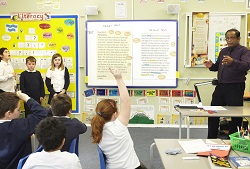- Show any sort of text, image or drawing. Any small book becomes large and visible. The whole class can see any printed item without the need for photocopying.
- Whilst reading aloud, place items that are in the story on the visualiser to help younger children to understand more fully and engage different learning styles.
Use visualisers at key stages three and four to strengthen grammar, comprehension and writing skills:
- Compare different writing styles. For example, show a piece of poetry side by side with a piece of narrative and show how they differ.
- Show any sort of text, image or drawing without the need for photocopying. Saves time and money and allows you to share copyright protected material.
- Highlight passages in books for class discussion. Some visualisers have interactive pens, or combine with an interactive whiteboard to draw attention to specific passages or phrases.
You can incorporate demonstrative, explanatory, peer assessment and critical thinking skills with more effectiveness by using a visualiser in your literacy lessons. The above tips will go a long way towards making your lessons more interactive, and helping young pupils retain their literacy learning more effectively.
Of course, this list is not exhaustive and we'd be intrigued to hear of other ways that teachers have used a visualiser to enhance the teaching of literacy. If you have an innovative technique in mind, do leave a comment below.


















